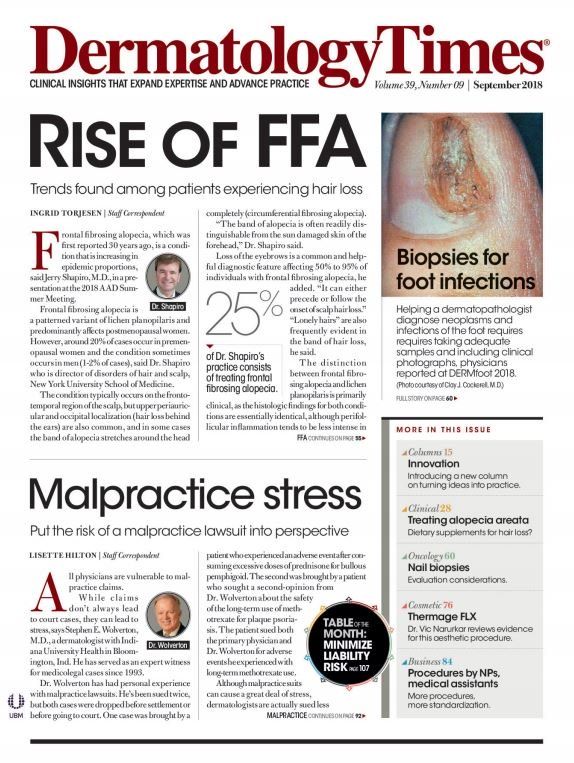- Acne
- Actinic Keratosis
- Aesthetics
- Alopecia
- Atopic Dermatitis
- Buy-and-Bill
- COVID-19
- Case-Based Roundtable
- Chronic Hand Eczema
- Chronic Spontaneous Urticaria
- Drug Watch
- Eczema
- General Dermatology
- Hidradenitis Suppurativa
- Melasma
- NP and PA
- Pediatric Dermatology
- Pigmentary Disorders
- Practice Management
- Precision Medicine and Biologics
- Prurigo Nodularis
- Psoriasis
- Psoriatic Arthritis
- Rare Disease
- Rosacea
- Skin Cancer
- Vitiligo
- Wound Care
Publication
Article
Dermatology Times
Ovarian reserve low in premenopausal women with psoriasis
Author(s):
Reproductive age women with psoriasis could benefit from an endocrinologist or obstetrician referral before starting systemic therapy.
Reproductive age women with psoriasis could benefit from an endocrinologist or obstetrician referral before starting systemic therapy, a study shows. (©GraphyxPhoto/Shutterstock.com)

Women with psoriasis could have a harder time getting pregnant, according to new research.
Based on a study published in the Taiwanese Journal of Obstetrics & Gynecology, these patients have a diminished ovarian reserve or a number of follicles capable of producing a mature, healthy egg for fertilization.
Current data suggests female hormones released during pregnancy impact the course of psoriasis, and, at the same time, psoriasis affects pregnancy outcomes. However, no previous research exists into the ovarian reserve and function of psoriatic patients.
According to study authors, knowing how psoriasis might affect pregnancy chances can be very important for women interested in having a family.
“Average age of diagnosis in women with psoriasis is 28, a prime age for pregnancy,” the authors wrote. “Therefore, many female patients with psoriasis are concerned about adverse effects of the disease on their future fertility.”
Although age is a factor in determining whether a woman can get pregnant, it has limited usefulness in predicting individual ovarian performance. Consequently, knowing a woman’s ovarian reserve is increasingly important clinically.
And, the measure of a number of factors can help determine the quality of a woman’s ovarian reserve. These include basal follicle stimulating hormone (FSH), estrogen (E2), FSH/luteinizing hormone (LH) ratio, Inhibin B, and antimullerian hormone (AMH). Ovarian volume (OV) and antral follicle count (AFC) determine ovary size and shape.
THE STUDY
The study, conducted between January and September 2014, occurred in Aksaray University Research and Training hospital in Turkey. It was designed to determine whether women with psoriasis who hadn’t undergone previous treatment had a reduced ovarian reserve compared to women without psoriasis. They also investigated if disease severity was associated with ovarian reserve.
Researchers selected participants based on their type of psoriasis, presence of hair and nail psoriasis, and the severity of disease. Participants were excluded for infertility, pregnancy, gynecological pathologies, polycystic ovarian syndrome, breastfeeding, gynecological surgery history, chronic liver or kidney failure, smoking, cancer, or other dermatological, inflammatory, physical, or psychiatric disorders. Women who previously received any systemic treatment and hormone medication were also excluded due to potential effects on ovarian function.
Researchers enrolled 14 women with psoriasis for this study. Nine had plaque type psoriasis, three had guttat type, and two had palmoplantar type. A control group of 35 women without psoriasis also participated. The median age of the psoriasis group was 31 with an average body mass index of 27.39. The control group was statistically similar with an average age of 29 and 24.24, respectively. The median age for women in both groups for their first period was 13.
OVARIAN FUNCTION
To determine ovarian function, investigators took blood samples from both groups during their menstrual cycle’s early follicular phase (days 2-4) to analyze E2, FSH, LH, and thyroid stimulating hormone levels. A gynecologist also used transvaginal ultrasound to assess women’s ovarian volume and to measure total antral follicles sized 2-10mm in diameter.
According to study results, participants with psoriasis had substantially higher FSH levels than the control group (6.76 (1.96); 5.71 (2.24), respectively, p<0.05). Higher FSH levels indicate follicle depletion. Additionally, FSH/LH ratio was higher in psoriasis patients than the control group (1.52 (0.86); 0.92 (0.54), respectively, p<0.05). This ratio also points to a diminishing ovarian reserve. Psoriasis patients’ AFC was also significantly lower than the controls’ (5 (2.5); 7 (4.5), respectively, p<0.05). AFC is known to decline with age.
However, there were no noticeable differences among other hormone levels, ovarian, or uterus volumes.
“Results support diminished ovarian reserve in premenopausal women with psoriasis,” the authors wrote.
Findings did not indicate a significant difference in the incidence of spontaneous abortion between women with psoriasis and the control group. Existing research is also contradictory on the rate of this pregnancy outcome.
The study did have limitations, the authors wrote. Investigations didn’t adequately assess AMH levels. This measurement is a leading clinical ovarian reserve assessment factor. In addition, the patient population didn’t include enough women with severe psoriasis.
Based on study findings, women of reproductive age with psoriasis could benefit from additional medical services surrounding pregnancy, according to the authors.
“Early referral to a reproductive endocrinologist or obstetrician when there is a risk of diminished ovarian reserve can improve pregnancy planning and management, especially before starting systemic treatment for psoriasis,” they wrote.
References:
Alhan A, Ayanoglu BT, Ozdemir E, Turkoglu O, Diminished ovarian rescue in patients with psoriasis, Taiwanese Journal of Obstetrics & Gynecology (2018); doi:10.1016/j.tjog.2018.02.010.

Newsletter
Like what you’re reading? Subscribe to Dermatology Times for weekly updates on therapies, innovations, and real-world practice tips.















